A glider crashed near the summit of Mount Tauhara, Taupō, killing the two people on board – an instructor & student. Safety issues relate to pilot competency associated with ridge soaring and instructor training at Taupō. TAIC has recommended that Taupo Gliding Club and Gliding NZ upgrade their systems to improve safety.
Executive summary Tuhinga whakarāpopoto
He Whakamihi
Acknowledgement
E mihi ana te Kōmihana ki a Tauhara Maunga, ōna tāngata, me te iwi o Ngāti Tūwharetoa i mahi tahi i raro i te rangapū me te Kōmihana i te uruparetanga ki tēnei aituā. Ka mihi hoki ngā Kaikōmihana ki te Tarahiti mō Tauhara Maunga, te kaitiaki o Tauhara Maunga i runga i te mōhio he tipuna maunga tēnei nō ngā hapū o Tauhara. E whakamaioha ana te Kōmihana mō te āwhina kia uru atu ki taua wāhi, me te tautoko kia arohia te tikanga i te whakahaeretanga o tana whakatewhatewha.
The Commission acknowledges Tauhara Maunga, its people, and the people of Ngāti Tūwharetoa for their partnership in responding to this tragic event. The Commissioners thank the Tauhara Mountain Trust, the kaitiaki for Tauhara Maunga which it recognises as an ancestor for ngā hapū o Tauhara. The Commission extends their appreciation for assistance in access to the site and support to conduct its investigation in a culturally appropriate way.

(Credit: Taupo Gliding Club)
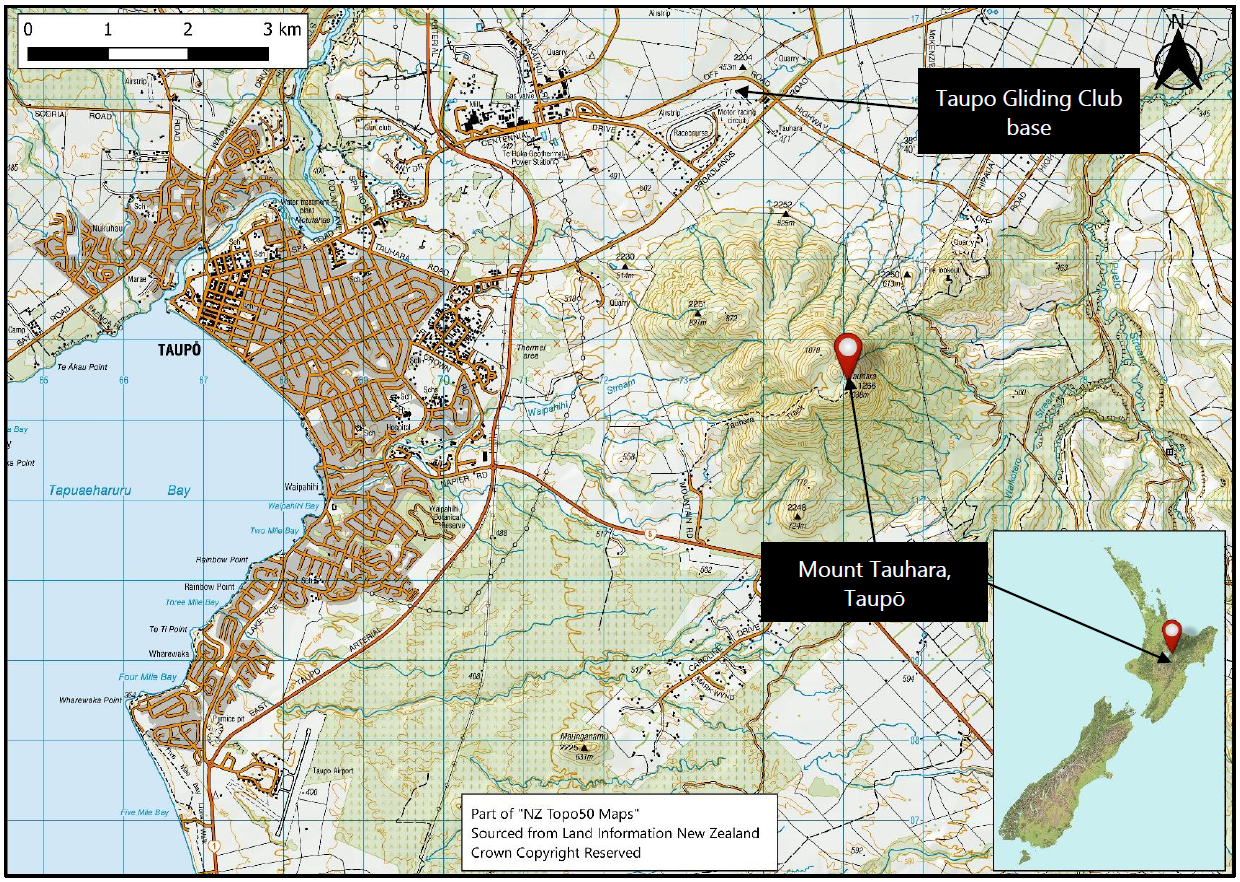
What happened
- On 31 May 2020, an instructor from the Taupo Gliding Club conducted a trial flight with a short-term member (the student). The flight was the second of the day for the instructor, who had previously flown a similar trial flight with another short-term member.
- The instructor flew over the Mount Tauhara walking track near the southeastern face of the mountain. The glider was observed by witnesses walking the track from near the trig station on the summit. The glider was last seen flying past the trig station at about the same height as the trig station, but on the downwind side and with the left wing down. The witnesses saw and heard the glider’s left wing strike scrub and, as it subsequently went out of their sight, they heard further sounds of impact. Neither occupant survived the accident.
Why it happened
- The Transport Accident Investigation Commission found that the glider impacted terrain while the instructor was likely attempting to escape from a situation where the glider was at a low height above the mountain and downwind of the ridge face. Despite the instructor’s efforts to manoeuvre the glider away from rising terrain on the right-hand side, a collision with the terrain became unavoidable.
- The Commission found that the Taupo Gliding Club had limited systems in place to positively verify that pilots had an appropriate level of competency to soar on Mount Tauhara.
- The Commission also found that the Taupo Gliding Club procedures for instructor training and ongoing competency were not in accordance with Gliding New Zealand’s Manual of Approved Procedures.
-
The Commission made two safety recommendations:
• One to the Taupo Gliding Club to develop a system to ensure local instructors are able to positively verify that pilots have appropriate levels of competency to ridge soar on Mount Tauhara and safely conduct training flights on the ridge.
• One to Gliding New Zealand to review how gliding club instructors are trained and clubs are audited, and then take corrective action to ensure that all new instructors are consistently trained to the standards set out in the Manual of Approved Procedures.
What we can learn
- Ridge soaring has inherent risks due to factors such as turbulent wind conditions, unpredictable updrafts and proximity to terrain, and pilots must be competent in the correct techniques in order to manage these risks.
- Trial flights should be conducted in environments that meet the intent of the flights without introducing unnecessary risks.
Who may benefit
- Gliding clubs, glider pilots, instructors and personnel involved with glider flying activities and aviation regulation within New Zealand will benefit from this report.
Factual information Pārongo pono
Narrative
- At 1416 on 31 May 2020 (all times in this report are New Zealand Standard Time (NZST)), an ASK21 Glider, registered ZK-GTG (the glider), owned and operated by the Taupo Gliding Club (the club), departed from the Centennial Park aerodrome for a ‘trial flight’, the second one that day. This type of flight is used by gliding clubs to introduce potential new members to the sport. On board was an instructor (the instructor) and a member of the public who had joined the club as a short-term member for a trial flight (the student). (The report uses the term ‘student’ to label the person in the front seat of the glider involved in this accident. Gliding New Zealand Advisory Circular 1-04 Trial Flights refers to them as a student who is a short-term member of a club. That person is defined as a ‘crew member’ under the Civil Aviation Rules (CARs). The report’s use of the term ‘student’ should not be confused with a ‘student pilot’ under the CARs, its being a role not applicable here.)
- The glider was aerotowed to an altitude of 5000 feet above mean sea level (amsl), a launch height of about 3500 feet above the ground level, and released from the tow plane over the northern region of the Taupō township. Sometime after the release, the instructor flew south to the southeastern face of Mount Tauhara (see Figure 8 for an orientation of the mountain).
- Some walkers on the mountain track reported that they observed the glider flying above the southeastern face of Mount Tauhara near to points on the ground locally known as Rocky Point and The Trig. Some of these witnesses reported later that they saw the glider fly in a northerly direction to the west of the trig station at the mountain’s peak and then descend and impact with terrain just below the trig station (see Figure 3). Timing from various sources confirmed that the accident occurred at about 1433.
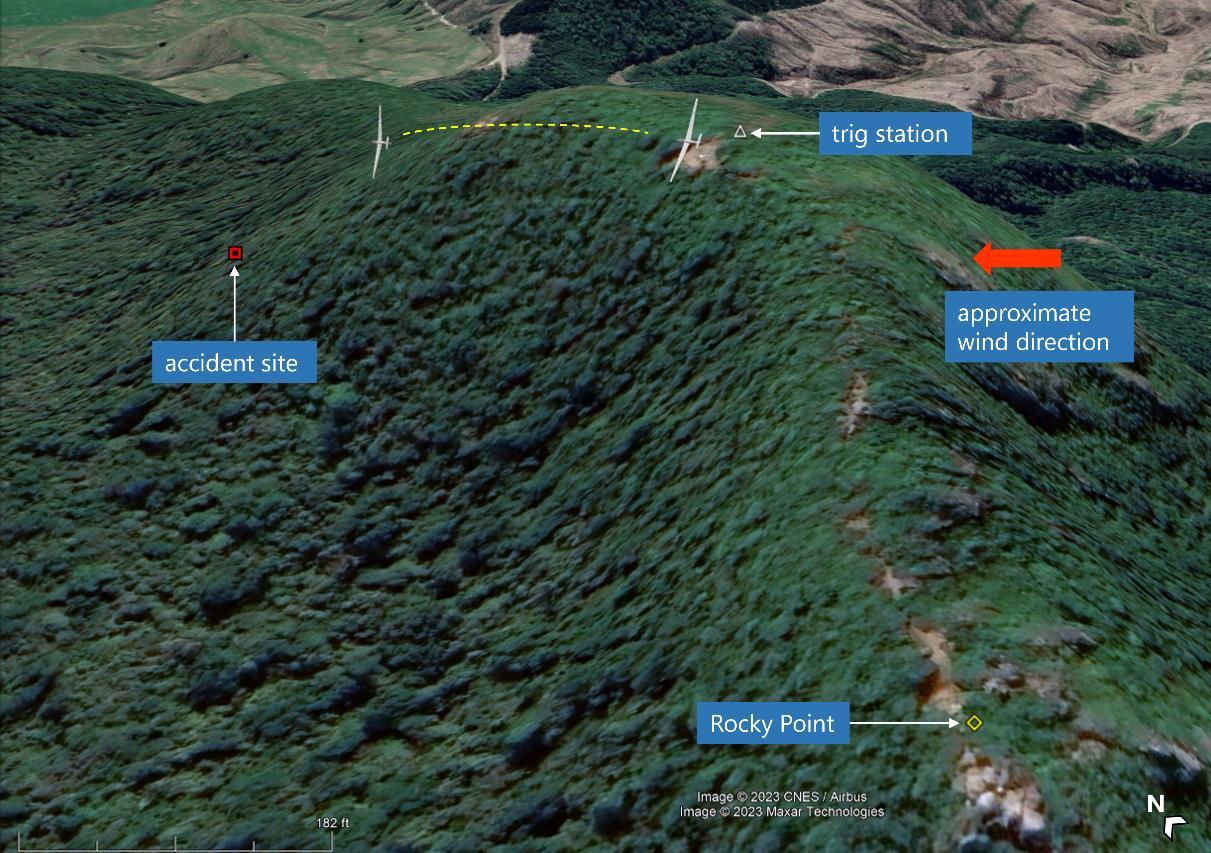
(Base picture from Google Earth Pro)
- Emergency services were called and some people on the mountain went to assist. Neither the instructor nor the student survived the accident.
- The accident flight was the second trial flight that day with the same instructor. The first flight had taken off at 1338 and landed at 1408. The student in the first flight had taken photographs and video during that flight.
- The normal plan for trial flights at Taupō was an aerotow launch to 5000 feet amsl followed by a flight of 20–30 minutes’ duration. They were intended to provide students with an opportunity to take the controls and get used to the experience of flying in a glider.
Personnel information
- The instructor had started learning to fly gliders in England in 1975, then stopped in 1979 with about 63 hours’ total experience, which included some cross-country flights. They had recommenced training 35 years later, in New Zealand in 2014. They had had the option of having their past gliding experience recognised (the total gliding time shown in Table 1 includes experience recorded in England. It is the corrected amount after reconciling a double entry by the pilot) but had chosen to restart training as a trainee glider pilot in New Zealand under the current training scheme with a new logbook. This would take them through the A and B certificates to being a qualified glider pilot.
- The instructor had been predominantly living in the Northern Hemisphere, but had recently been following the global summer with residences in both hemispheres. From 2014 they had travelled between New Zealand, England and France, flying gliders in all three countries and using their New Zealand logbook to record their flight times. They were a member of the club and flew at Centennial Park when in New Zealand.
- The instructor had a New Zealand medical certificate type DL9 (New Zealand Transport Agency Waka Kotahi, Medical certificate for Driver Licence, form DL9), which was current to November 2020. They had gained a New Zealand Qualified Glider Pilot certificate in March 2015 and a passenger rating in December 2016. In 2017 they had completed a ‘Silver’ badge award (a Silver badge award by the Fédération Aéronautique Internationale has three parts that can be obtained in one flight or separately: a minimum height gain, a minimum duration flight and a minimum cross-country distance flight) in France with the cross-country distance leg.
- The instructor had started training to be an instructor with the club towards the end of 2015 and had gained a ‘C’ Category instructor rating on 20 February 2018. They had been upgraded to a ‘B’ Category instructor rating by the club’s instructor trainer on 8 March 2019 and their gliding Biennial Flight Review (BFR) was current at the time of the accident (see Table 1 below).
- The instructor had also learnt to fly powered aircraft from 1989 and had continued to fly these, gaining a private pilot licence (PPL) and a glider towing rating valid in France and New Zealand. They had also obtained an instrument and aerobatic rating for powered aircraft.

Aircraft information
- The glider was a two-seater Alexander Schleicher GmbH and Co. ASK 21. It was manufactured in November 2009. The club purchased the aircraft new and registered it with the Civil Aviation Authority of New Zealand (CAA) as ZK-GTG.
- The glider was issued with a Certificate of Airworthiness by the CAA on 12 January 2010. Its last maintenance inspection was performed on 5 January 2020. It had accumulated 3027 flight hours as recorded in the logbook on 21 March 2020.
- The last Annual Review of Airworthiness was issued on 23 October 2019. All maintenance on the glider was current, but the 24-month Avionics (and Instrument) Inspection (this inspection included an altitude encoder and an air traffic control (ATC) transponder unit used to show the glider’s position and altitude to the ATC when in controlled airspace) was due on the day before the accident and had not been conducted.
- All the applicable Airworthiness Directives and Service Bulletins were found incorporated or complied with at the time of the accident date.
- The glider had a current weight and balance certificate with an empty weight of 392.9 kilograms (kg), and a minimum cockpit weight of 75 kg was permitted in the front seat. The glider’s flight manual stated a maximum of 110 kg was permitted in each seat.
- The glider had a maximum take-off weight of 600 kg. The cockpit loading must not exceed the aircraft take-off weight limit and it must be distributed to maintain aircraft balance within the range of acceptable movement for the centre of gravity, from 234 millimetres (mm) aft of datum for the heaviest load back to 469 mm aft of datum (datum point for the ASK 21 is at the leading edge of the wing) for the lightest load.
- The glider was fitted with a mechanical variometer system with an indicator in the front cockpit instrument panel. An electric variometer with audio was also installed with displays in the front and back cockpits. When switched on, the audio emitted a tone that changed in pitch, depending on whether the glider was experiencing lift or sink conditions. This allowed the pilot to focus their attention outside while soaring and to see and avoid other gliders in thermals. It was controlled from the front-seat position where the student was seated. The audio was selected off for the two trial flights.
- It is standard practice for gliders in New Zealand to carry daily inspection books. They are used to meet the Civil Aviation Rule (CAR) requirement (CAR Part 104.113 Technical Log – the requirements for this are met by using GNZ form TECH 19a and the yellow DI book) for a technical log to be carried in an aeroplane for pre-flight planning. The daily inspection book for this aircraft was usually stowed in a side pocket in the rear cockpit, but was not found with the wreckage or at the club premises.
Meteorological information
- The MetService forecast for the area on the afternoon of 31 May 2020 was nil significant cloud or wind with a 30 kilometre visibility. The forecast wind for Central Plateau at 3000 feet was 070 degrees (°) true (a bearing relative to the Geographical North Pole rather than the Magnetic North Pole. At Taupō in 2020 it was 21° east of the Magnetic North Pole) at 15 knots (kt) and at 5000 feet it was 060° true at 10 kt. The observed cloud formation consisted of high cirrus cloud cover and a lower layer of scattered cumulous clouds, with a local cloud base height of around 4800 feet.
- The automatic weather station at Taupō aerodrome recorded the wind at 1530 on that day as being 110° true at 13 kt.
- The wind at the club site, from photographs of the windsock, was approximately aligned with Runway 07 at about 15 kt, which is from 090° true.
- The wind strength and direction at Mount Tauhara on the day was estimated from: witness reports and; the crabbing angle as observed in the first student’s GoPro video, that the glider flew to maintain track over the ridge. The estimated wind strength was 12–16 kt from about 120° true.
Communications and aids to navigation
- The glider was fitted with a single, very-high-frequency transmitter/receiver radio. It had multiple channels and was selected to the Centennial Park aerodrome frequency.
- The glider was fitted with an altitude encoder and transponder, but was not required to have an emergency locator transmitter and none was fitted.
Aerodrome information
- The club operates from the Centennial Park aerodrome located north of Mount Tauhara and east of Taupō. It is an unattended and non-certified aerodrome at an approximate elevation of 1500 feet amsl. The aerodrome has a grass strip with two vectors. On the day of the accident, gliders were taking off on Runway 04 with a slight crosswind from the right and landing directly into wind on Runway 07.
Recorded data
- No flight track information was available for the accident flight.
- Video of the first trial flight was obtained from the first student’s GoPro. It was possible that the student in the accident flight took photos or videos on their cell phone, but no data could be recovered from it.
Site and wreckage information
- The glider’s flight path immediately before impact, as confirmed by witness reports and ground impact scars, was at a height that was about level with the trig station and slightly to the west. The glider was seen heading in a northerly direction (see Figure 3). Along the glider’s flight path, the ground level dropped away to a crater valley. That valley ended at a saddle at the edge of the mountain.
- The wreckage was located on Mount Tauhara approximately 110 metres north and 60 metres below the trig station (see Figure 4). The first part of the glider to impact the terrain was the left wing tip (see Figure 5). It cut a clearly defined left-hand, curved slice through the scrub and bush canopy (the red curved line in Figure 4). The glider fuselage impacted later during the accident sequence (near the arrowhead in Figure 4) in an almost vertical nose-down attitude.


- The glider continued to slide through the bush, with the right wing leading and the fuselage near vertical until the right wing lodged in a tree trunk. The fuselage fell back slightly, twisting the right wing. The tail section broke off just aft of the wings as the glider came to rest in the bush (see Figure 6).
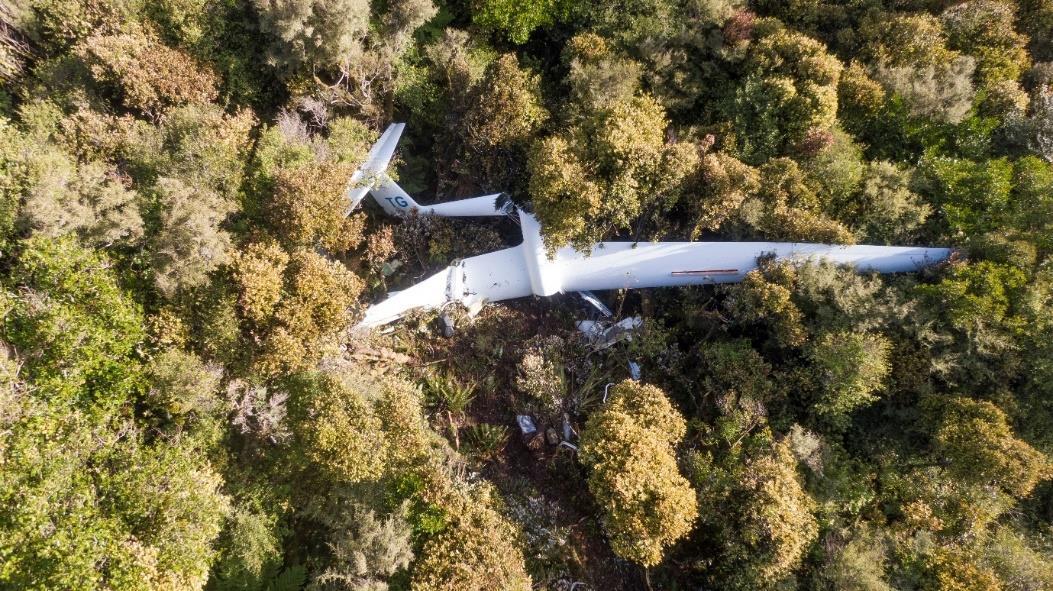
Ridge soaring
- Ridge soaring is a technique glider pilots use to gain altitude from a wind flow that has been deflected upwards when it flows over hills. If the glider can remain flying in the rising air it may gain altitude. When the wind is flowing perpendicularly to the hill or ridge line, the glider can be flown along the ridge and the pilot can convert height gain to forward speed and distance (see Figure 7).
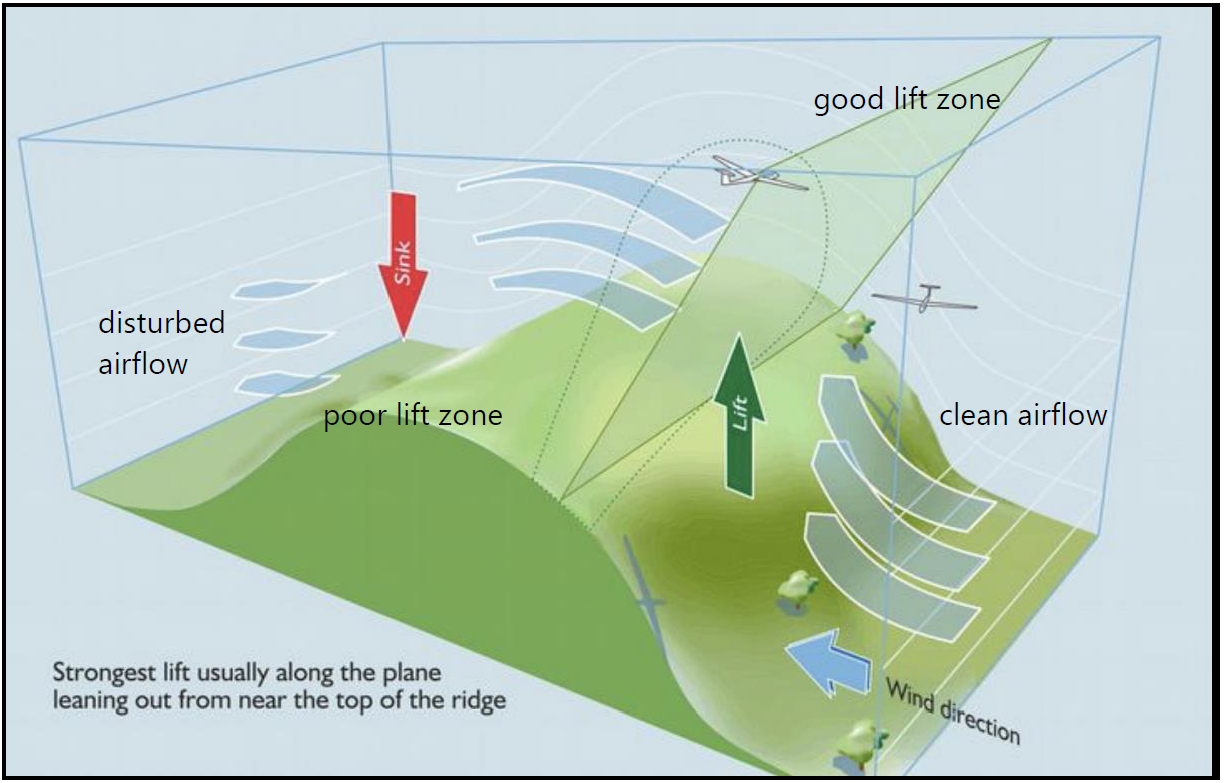
- A glider pilot needs to maintain a forward airspeed so they fly along the face of a ridge then turn and travel back the other way (in beats or regular strokes). The flight path loosely follows a figure-eight shape, with all turns away from the ridge and out into the wind. The lift is strongest slightly upwind of the ridge face, as shown in Figure 7.
- The pilot will crab slightly (fly sideways) into wind along each beat to maintain a position relative to the ridge face and the lift. If the glider’s airspeed is allowed to drop, the glider will drift downwind. Drifting downwind of a ridge could mean that the pilot no longer has the height available to convert to airspeed in order to fly back into wind to the area of lift. The wind speed over the ridge top may also increase near the ground due to the venturi effect (see planetary boundary layer (Skybrary, 2023) and Bernoulli’s Principle (Skybrary, 2023,1)), making an into-wind flight path more difficult from close to the ridge top.
- A list of safety principles was published in Gliding New Zealand’s (GNZ’s) Advisory Circular (AC) 2–13 Mountain & Ridge Soaring Safety Principles (this AC was published a month before the accident). Summarised key points are:
- safe speed: Always maintain a safe speed near the ground. (GNZ promoted at least three methods for calculating a safe speed, and they all ensured a safe margin was maintained above stall speed)
- turn away: Always make the first turn away from the ridge
- escape route: Always have an escape route planned that leads to lower terrain immediately, with a safe landing area
- dangerous hill tops: Beware of flying low and slow over gently contoured hill tops that have wide, rounded areas. If you need to escape, you may not be able to out-glide the terrain.
Soaring the ridges on Mount Tauhara
- Whichever direction the wind blows at Taupō, it may be possible to soar on one of the ridge faces of Mount Tauhara when the wind strength gets above about 12 kt. Unlike a traditional ridge as shown in Figure 7, Mount Tauhara is approximately conical. The conical shape presents an obstacle to the wind, which then follows the path of least resistance over or around it. That could be left or right rather than up and over the top, and consequently ridge lift at Mount Tauhara can be confined to narrow bands (sometimes called fingers) and be associated with turbulence.
- Mount Tauhara has four main faces that can be soared (see Figure 8): the north face near the club’s base, the southwestern face near the township, the eastern face near a quarry, and the southeastern or back ridge on the opposite side of the mountain from the base. Some faces produce stronger lift than others and some are shorter in length. If the wind changes (in either direction or strength) the lift may also increase or reduce or shift to a different face.
- The wind was from the southeast on the day of the accident, as shown with the blue arrow in Figure 8. The approximate glider flight path on the ridge runs, as determined from the video of the first flight, is shown as a red double-pointed line.
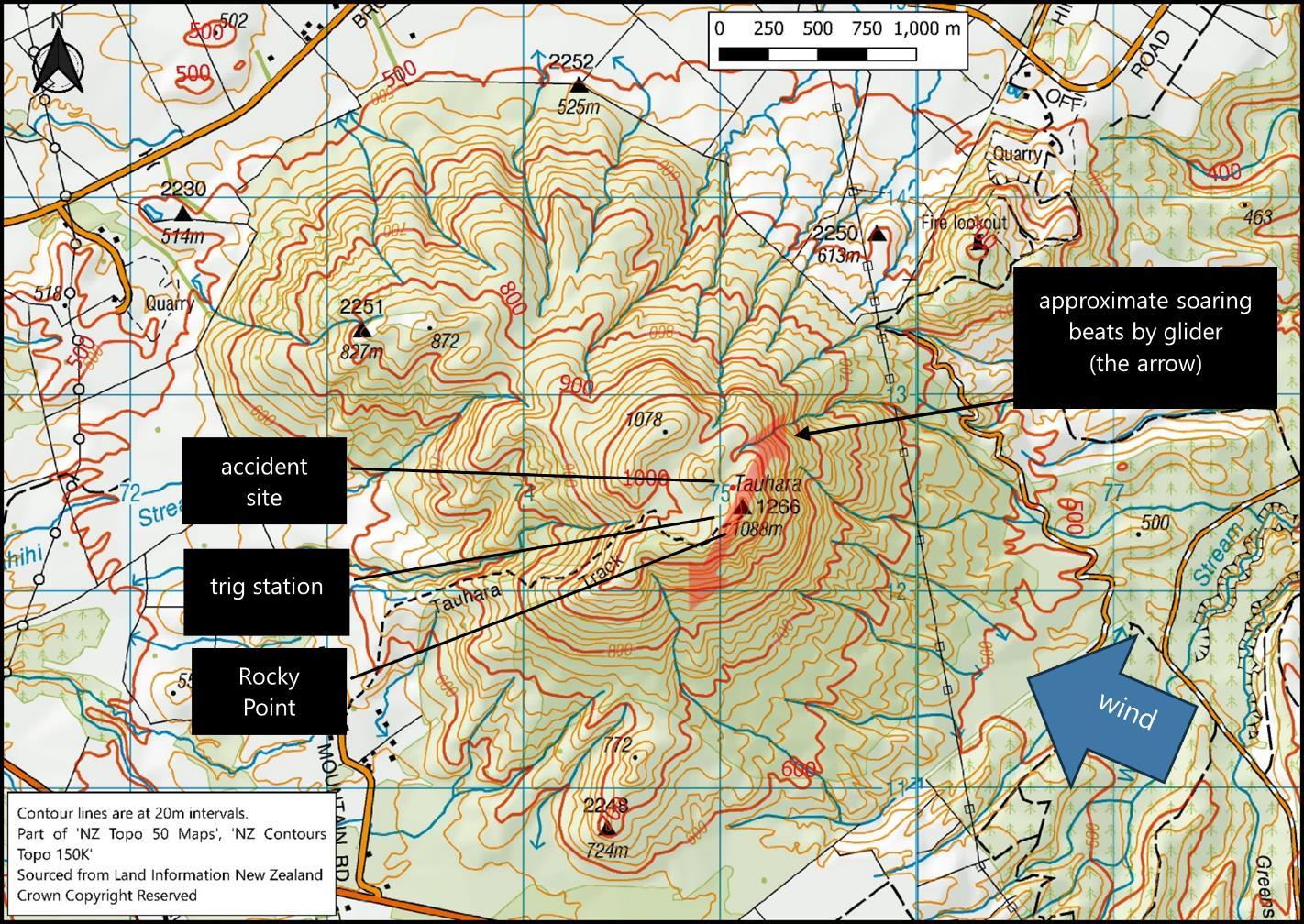
Medical and pathological information
- The instructor’s medical history did not contain anything of significance to the accident.
- The pathologist’s autopsy report showed nothing remarkable with the instructor. It identified the presence of hypertensive disease. There was no evidence of recreational drugs or alcohol use.
- The autopsy report for the student found no evidence of recreational drugs or alcohol use.
Organisational information
- Gliding operations in New Zealand must be conducted in accordance with CAR Part 104. This sets out the minimum requirements for gliding activities and operations, and any exemptions for gliding activities otherwise required by other rule parts.
- GNZ is the aviation recreational organisation certified under CAR Part 149 to oversee gliding operations in New Zealand. Part 149 sets out the requirement for the organisation to have a management structure and a documentation system to ensure that gliding operations are conducted in a safe manner. GNZ’s exposition describes how the organisation is to be managed to achieve the objective of CAR Part 149. Key documentation is the GNZ Manual of Approved Procedures (MOAP) (current at the time of the accident, MOAP AL32, effective date: 22 October 2019) and GNZ’s ACs (the GNZ Advisory Circulars provide advice to affiliates on how to comply with the requirements of the MOAP. They may also provide information of a more general nature).
- Most glider pilots in New Zealand are members of gliding clubs under the umbrella of GNZ. The GNZ President and National Operations Officer (NOO) issue glider pilot certificates and glider instructor ratings (pilot certificates and ratings are issued by GNZ, whereas licences are issued by the CAA (see Glossary)) under delegation from the Director of Civil Aviation New Zealand.
- A gliding club must become affiliated to GNZ if it wishes to operate under GNZ’s Part 149 certificate. Club members must operate in accordance with GNZ’s MOAP. Affiliated clubs have their own sets of rules and operating procedures that require their members to comply with the GNZ MOAP. GNZ audits affiliated member clubs to ensure compliance with GNZ procedures and provides Regional Operations Officers (ROOs) to interact with the clubs on a regular basis. The club was an affiliated member of GNZ.
- Gliding is a recreational sport. All positions of responsibility within GNZ and individual gliding clubs are held by volunteers.
- The CAA audits GNZ, and also samples affiliated clubs, to ensure GNZ operations are compliant with CAR Part 149.
- Commercial glider operations are only permitted to take passenger flights under CAR Part 115. Under this rule part, a certificated operator must use glider pilots who hold commercial glider pilot licences (CPL(G)s) to take commercial glider flights. At the time of the accident there were no commercial glider operations active in New Zealand.
- CARs also provide for both private and commercial glider pilot licences to be issued directly by the CAA. These types of licence require each pilot to have completed a specific training syllabus and then tested by an independent organisation contracted to the CAA to conduct flight examinations. A CPL(G) is required before a pilot can take passengers or goods for hire or reward. It requires the pilot to have a Class 1 CAA medical. Alternatively, a glider pilot may apply for a private pilot glider licence PPL(G), under which they are only required to have a Class 2 CAA medical.
- In June 2023 the CAA database showed that there were 13 people in New Zealand with CPL(G) licences (of which only three held current Class 1 CAA medicals to allow them to operate in that capacity) and 15 people with PPL(G) licences (of which only four held current Class 2 CAA medicals to allow them to operate in that capacity).
Analysis Tātaritanga
Introduction
- This accident occurred during what should have been an uneventful trial flight intended to introduce a student to a new experience of flying in a glider. The flight was conducted at an altitude and distance from the aerodrome that would have ensured enough height over the general terrain to allow for an uneventful glide back to the aerodrome. The glider was seen flying above the walking track on Mount Tauhara and then later as it flew past the trig station immediately before it impacted the mountain. The accident site was approximately 2000 feet above the aerodrome and easily within gliding distance at 4 kilometres away.
- The following section analyses the circumstances surrounding the event to identify those factors that increased the likelihood of the event occurring or increased the severity of its outcome. It also examines any safety issues that have the potential to adversely affect future operations.
What happened
- The glider departed from the club’s base for the second trial flight of the day at about 1416.
- At about 1435, witnesses saw the glider fly past the trig station at about the same height as the trig station (see Figure 3). It had approached from Rocky Point and was to the west of the ridge that ran between the trig station and Rocky Point. It was heading in a northerly direction. Several witnesses recalled that the left-hand wing was much lower than the right as it passed the trig station, and those at the trig station recalled the glider being very low and close to them as it flew past.
- The glider then impacted the mountain in a left-wing-down attitude, soon after passing the trig station.
Avenues of inquiry
- The Commission considered several potential contributing factors for the glider’s impacting the mountain. These are discussed below.
Airworthiness
- The glider was reportedly airworthy when it departed from the aerodrome. The daily inspection book was not found with the wreckage or at the club premises. Based on the damage to the glider cockpit area, it is very likely that the book fell out during the accident sequence and was lost at the accident site. Without the daily inspection book, the Commission was unable to verify that the daily pre-flight inspection had been completed. The club manager reported seeing the accident instructor conduct the daily pre-flight inspection, so it was very likely that it had been completed and signed.
- The aircraft logbook showed that all checks and maintenance had been completed as required when due, except for the avionics inspection, which had expired the day before. The overdue avionics inspection would not have affected the safety of the flight.
- The first trial flight of the day was recorded on video by the student on board that flight, and it showed that the glider was operating normally. The front seat’s mechanical variometer had been working but became stuck on maximum lift at some point during the first flight, then subsequently released while the glider was on the landing roll. The instructor had turned on the electric variometer without the audio and the student’s video showed that it was working. Neither of the variometers was essential for the flight.
- It is therefore very likely that the glider was airworthy on the day of the accident flight and immediately before its impact with the mountain.
Weight and balance
- A glider must be operated within its certified weight and balance limits. Based on the instructor’s and the student’s weights recorded by the pathologist, and the absence of the club ballast weights normally placed under the front seat cushion, the glider weighed 572.9 kg on the accident flight. This was less than the maximum rated take-off mass, and the front-seat load was above the minimum limit. The calculated centre of gravity for the accident flight was 344 mm aft of datum, which was within the acceptable range of movement.
- Therefore, the glider weight and balance were very likely within the acceptable weight and balance limits at the time of the accident.
Medical
- The instructor had a current medical certificate to operate as both a gliding instructor and a tow pilot. The autopsy report found evidence of hypertensive disease. The Commission’s medical advisor reviewed the autopsy report and the instructor’s medical records from the CAA, and discussed the instructor’s records with the CAA’s medical examiner. There was no evidence to suggest pilot incapacitation.
- It is very unlikely that medical factors contributed to this accident.
Flight path over Mount Tauhara
- A briefing was conducted before the first trial flight; it involved the club manager, the tow pilot, the accident instructor (who was also the club duty instructor that day) and another instructor. The club manager’s account of the briefing included discussing the runway-in-use and flying conditions. The conditions at Mount Tauhara were also discussed, with there being a 10–12 kt wind over the east face. The club manager recalled stating, “It would be better to stay over the airfield at 5000 feet (the Commission clarified the intent of this statement with the club manager to be that trial flights should be conducted within the vicinity of the airfield), as the east face [Mount Tauhara] could be a little rough.”
- Video evidence of the first trial flight shows the glider flew over Mount Tauhara during the flight. The instructor commented to the ground handler while on the ground between the two trial flights, that the ridge was working (‘working’ in this context means the ridge was producing lift). The second trial flight, the accident flight, was also flown over Mount Tauhara.
- The Commission could not determine why the trial flights were conducted over Mount Tauhara, but the flight path as conducted increased the risk of an accident occurring.
Glider positioning relative to the mountain
- When flying near to a ridge, the position of the glider relative to the slope is important. Pilots must be aware of the wind direction and where the lift is strongest and avoid getting downwind of the ridge face. The glider must maintain an appropriate component of into-wind speed near a ridge to maintain a relative position over the ground. If this component reduces, the glider will drift downwind.
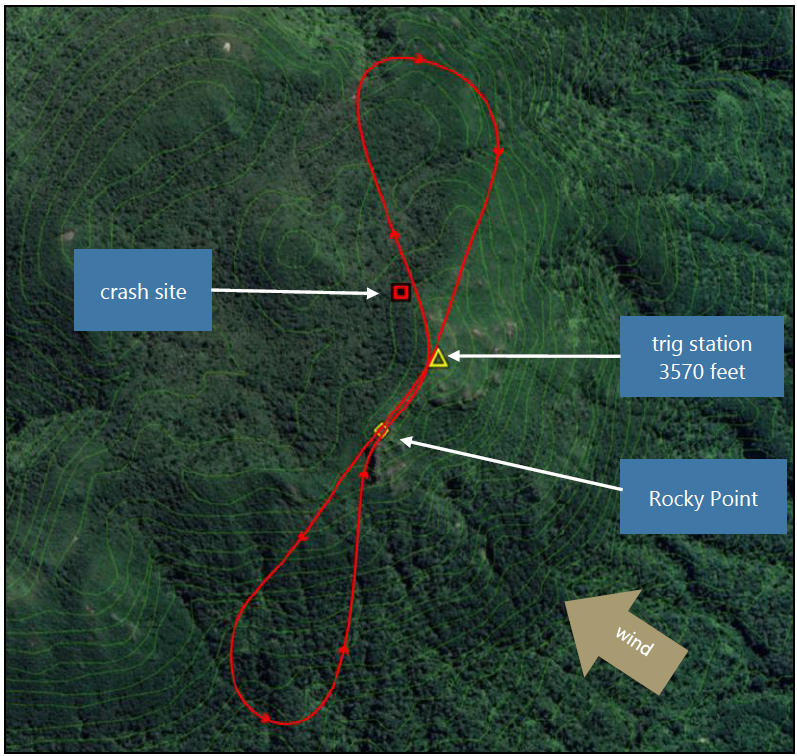
- Pilots must maintain awareness of gliders’ relative positions over ridges, and alert to areas of high risk. If a pilot allows a glider to get too close to the ridge or drift downwind of the crest, they need to respond promptly and have an escape route in mind that leads to lower ground.
- In the first flight, the instructor approached Mount Tauhara from the south over Rocky Point then flew north and to the left of the trig station with 50–100 feet clearance above the top of the mountain (see Figure 9).
- On the accident flight the instructor flew just downwind of the ridge face in the poor lift zone (see Figure 3 and Figure 7). The glider’s very low height above the mountain top reduced the instructor’s margin to manoeuvre the glider away from the mountain. Additionally, the downwind position resulted in the glider flying in the wind shadow of the mountain, and being exposed to a more disturbed airflow and possibly turbulence. These factors very likely contributed to the glider’s impact with the terrain.
- It is unknown why the instructor allowed the glider to become positioned in such a way that no safe escape options remained (see Figure 3). The proximity of the glider to the terrain meant that any remaining margin of safety could very quickly reduce, particularly if the airspeed were allowed to decrease.
- Pilots can be distracted by a number of sources inside and outside the cockpit. Alternatively, they may become overly focused on a particular task to the detriment of a wider environmental scan. Regardless, if an instructor’s situational awareness is compromised, either by their not perceiving subtle cues that the margins are reducing, or by their not fully comprehending how the glider’s current position would affect its future dynamics, recovery from the situation would become increasingly difficult.
Speed control
- The general formula taught by the club instructors at the time for deciding on the minimum safe speed at which to fly near the ridge was: stall speed, plus 10 kt, plus ½ the wind speed (the GNZ Moodle training system for ‘Safe Speed Near the Ground’ (CAA audit of same, dated 2 June 2020)). The glider’s stall speed was estimated at 39 kt from the table on page 25 of the Flight Manual, using the calculated centre of gravity with the crew at the time (this was calculated to be 337 mm aft of datum). Therefore, with a wind speed of 15 kt, the minimum safe speed near the ridge would have been 56 kt. A more recent version of the formula used by the club in its training PowerPoint is: 1.5 x stall speed + ½ wind speed. The result for the ASK21 Glider with this formula would have been 66 kt.
- While ridge flying and close to the ground, it is imperative for a glider pilot to constantly monitor and control airspeed. A glider pilot becomes skilled at detecting instantaneous changes in airspeed by the feel of the controls and the sound of the air flowing past the canopy. The airspeed indicator will lag slightly.
- The Flight Manual (revision TN23, page 25, section IV.6. Low speed flight, wing dropping and spins) describes the ASK21 Glider’s low-speed flight and stall characteristic as benign. Aileron control is still effective down to minimum speed (in this sense, minimum speed refers to the speed being near the minimum sink rate speed or to the stall speed. They are both important for low-speed flight) to maintain level wings, and normal rudder movement with up to 5 per cent yaw will not lead to a wing drop. A rapid pitch increase of 30 per cent to initiate a stall does not cause a wing to drop, but only a gentle drop of the nose. The sink rate will increase near the stall and the effects of turbulence and wind gusts are unpredictable. A slow airspeed could therefore feel as if the controls were responsive, but the glider would be quieter than normal and sinking more quickly than usual. The sink rate is shown on the variometer.
- On the first flight the instructor had maintained an airspeed of near to 50 kt while on the ridge, but had allowed it to reduce a few knots as the glider flew into rising air (lift). At one point, when the instructor had allowed the student to take the controls, the glider’s airspeed had dropped to 39 kt indicated (the estimated stall speed) as the student approached Rocky Point with an indicated altitude of 3600 feet. A significant period of the first trial flight’s airspeed near the ridge was at less than the club’s minimum safe speed of 56 kt as calculated above.
- There was no data available for the accident flight, therefore the Commission could not determine if speed control of the glider was a contributing factor.
Control of glider
- During the first trial flight of the day, the student was offered the controls soon after release, and later they requested another go near the ridge. The instructor agreed and allowed the student to have limited control for a short period, then to follow the instructor’s movements.
- The Commission could not determine if the student or the instructor was in control of the glider at the time of the accident.
Pilot competency associated with ridge soaring
Safety Issue: The Taupo Gliding Club had limited systems in place to ensure instructors could positively verify that pilots had appropriate levels of competency to ridge soar on Mount Tauhara and safely conduct training flights on the ridge. This increased the risk of an accident occurring.
- The instructor had a current ‘B’ Category instructor rating and was qualified to conduct this trial flight. At the time the instructor completed their training at Taupō, the GNZ syllabus comprised the basic manoeuvres and techniques required to fly a glider. Techniques such as ridge soaring were part of the ‘B’ certificate training and were only included in a pilot’s training if the local terrain was suitable for conducting such activities. Sign-offs for ridge soaring techniques could involve just a classroom lesson and would be either noted in the pilot’s logbook (older-style logbook) or included in the Qualified Glider Pilot check list. Advanced soaring training was generally self-initiated, where a pilot could seek specific experience at other clubs that had more suitable terrain for their desired type of soaring training.
- Soaring in ridge lift at Mount Tauhara was part of initial flying training at Taupō whenever the opportunity arose. The club had some safety guidance written into its rules about flying around the mountain. The club records showed that formal training documents had once been used to train pilots in the use of ridge lift on each of Mount Tauhara’s four faces. A model of the mountain was often used to demonstrate ridge soaring techniques to pilots during ground training sessions.
- Over time, and through members’ changing roles, ridge soaring training became less formalised. At the time of this accident there was no adequate system in place for instructors to verify that pilots had the appropriate levels of competency to ridge soar on Mount Tauhara apart from the standard check lists in logbooks and syllabus content sign-off for GNZ pilot achievement certificates.
Other factors
- The airbrakes were extended in the wreckage, as shown in Figure 6. These are typically operated by a pilot pulling the airbrake handle rearwards from the locked position. It is possible the instructor or student activated these. As the cockpit and all the control linkages were severely disrupted in the accident, the airbrakes were very likely extended by impact forces during the initial stages of the accident sequence.
- There was no evidence a bird strike had occurred.
Conclusion
- The lack of any formal training for club pilots to soar on Mount Tauhara, and a sign-off to verify that competency had been achieved, meant that the Commission was unable to determine the instructor’s ability to safely conduct the two trial flights over the mountain.
- The significant contributing factor to the accident was the choice of flight path over Mount Tauhara and the execution of it. The glider’s position relative to the mountain, at a very low altitude and downwind of the trig station, reduced the options available to the instructor, and increased the risk of an accident occurring.
Other factors that affect safety
Instructor training at Taupō
Safety Issue: The Taupo Gliding Club did not ensure GNZ instructor training procedures were fully implemented and GNZ audits did not detect this discrepancy. This increased the risk that instructors were not fully competent in all required areas.
- The club had a small and aging membership. It was run by a core group of volunteer enthusiasts, often supported by their families, and the club environment also provided social benefits to its members. This is a typical situation in small gliding clubs in New Zealand, where a clubs’ survival may depend on a few stalwarts willing to fulfil the key roles. The leading instructors in the club were in their 70s and the chief flying instructor (CFI) was planning to hand over the role to the accident instructor.
Competency reviews
- To continue exercising their flying privileges, all glider pilots in New Zealand must undergo BFRs. The club management had recognised the risks posed by its aging pilots, and changed the rules to require all pilots over age 70 to complete BFRs annually (Taupo Gliding Club rules 5.11.1(i)).
- GNZ requires instructors to undergo competency reviews at least every two years, to ensure that they are still competent to instruct and are familiar with current techniques. The MOAP allows instructors to use competency reviews to also serve as their BFRs, but the reverse does not apply. The competency and BFR reviews are significantly different. The BFR is for pilots. It’s a check that a pilot is current and safe to fly solo by them demonstrating their basic flying skills to ensure their continued ability to fly safely. The competency review is for instructor pilots. It’s a check that they are competent to instruct all flight training exercises by demonstrating their instructing technique
across the training syllabus. It also has a provision to limit an instructor’s scope to instructing specific exercises. - The competency review is further divided into two categories, each with its own form (form OPS 08 Competency review – new and intermediate instructors, and form OPS 09 Competency review – Advanced and senior instructors. (Both forms were dated June 2020)): one for new and intermediate instructors, and the other for advanced and senior instructors. The MOAP gives clubs the freedom to reduce the periods between instructor competency reviews to mitigate the effects of aging. A club, for example, could place limitations on an instructor to allow them to perform only a limited part of their role.
- The club’s practices had diverged from the requirements of GNZ. The CFI used just the BFR form to assess the competency of instructor pilots because they considered it covered the same requirements as the competency review. The CFI said they would conduct a BFR, then sometime later fill in the competency review form. The CFI might discuss with the pilot the exercises listed in the appropriate form. The club’s instructor trainer believed that the CFI could request any instructor to submit to a competency review, but they were usually used in special situations (eg, to check overseas pilots or if there were a particular concern with an instructor’s competency).
- The club tracked BFRs with other pilot records to ensure that all club pilots remained current, but there was no similar system for tracking a competency review where a pilot was also an instructor. Competency reviews were not conducted regularly and were not tracked to monitor their currency, and not all instructors had completed competency reviews in their club files.
- The MOAP (Part 2, section 2–4 Instructor ratings, item 14 – Currency requirements for instructor ratings) requires a competency review to be carried out by the CFI, an instructor trainer, a ROO or the NOO. A glider pilot’s logbook must be endorsed with a certificate to show appropriate currency and privileges in accordance with their competency review. The accident instructor’s logbook had not been endorsed with a competency review check. The instructor had not logged a glider flight with the club’s instructor trainer between the start of 2018 and the accident in May 2020, and the CFI had never flown with the instructor. The last check flight with a ROO or NOO had been on 21 January 2018 for the instructor’s ‘C’ Category instructor rating. The instructor had completed BFRs in New Zealand and instructors in France had conducted check flights with the instructor since 2018, but these were not substitutes for a logbook endorsement or a competency review in New Zealand. The instructor had completed a recent BFR, conducted by another of the club’s ‘B’ Category instructors, but this was not acceptable under GNZ procedures to allow the instructor to continue to instruct.
- The MOAP describes the requirement for an instructor to have a competency review less than two years old, and if not, that instructor is not considered current and not permitted to exercise the privileges of an instructor rating. The instructor did not have a current competency review, and had not flown with someone who was authorised to carry out a competency review in the 24 months prior to the accident.
GNZ audits
- GNZ holds an Aviation Recreation Organisation Certification under CAR Part 149 to conduct gliding operations in New Zealand. The club is affiliated to GNZ and thereby allowed to operate under the GNZ Part 149 certificate. The rules for training and instructor qualifications are defined in GNZ’s MOAP, and affiliated club operations are audited to ensure compliance. According to the GNZ quality management system (GNZ AC 1-01 ‘Quality Management), instructor ratings are audited every years two and four in a five-year audit cycle.
- A GNZ audit of the Taupō club activities was conducted in 2013, but the next one, due in 2015, was carried out three years late in 2018. The CAA audited GNZ in 2016, issuing a finding that GNZ had not audited three of the Central region clubs for more than 10 years (CAA finding 17F204).
-
GNZ audits of the club had not identified any discrepancies between the process that GNZ had set for ensuring instructor competency in the MOAP and how the club conducted local instructional processes. GNZ responded by stating that these audits were not exhaustive and only checked a sample of the operation at a time. The 2018 audit (GNZ General operations audit report, form OPS 15, audit date 13 October 2018) noted that there was “Good record keeping and accessibility of BFRs and instructor competency reviews”. Later in the comments, the auditor noted:
"The club is an exemplar of best practise in record keeping and in pro-active monitoring of its members’ flying currency.”
- The auditors were the ROO or the NOO. Their time was mainly voluntary and there was no requirement in their described duties (GNZ AC 2-01 Operations officers) for them to have been trained in auditing techniques. A club audit was usually conducted as part of a single-day visit to the club and was combined with check flights with selected members who were there at the time. The CFI at Taupō advised that they had never been taken by the ROO for a check flight.
Findings Ngā kitenga
- While the instructor was conducting a trial flight on the southeastern face of Mount Tauhara, it is likely the glider lost height and drifted downwind to a point where the instructor was unable to track back into wind. It is likely the instructor’s last option to avoid a subsequent collision with the terrain was to fly towards lower ground located downwind of the trig station.
- It is likely that the instructor banked to the left as they passed the trig station heading north, to avoid hitting the rising terrain near the trig station. The left wing would have been in the lee of the hill, and it was likely the pilot was unable to prevent the glider continuing to roll towards a near-vertical wing attitude. The subsequent contact made by the left-wing tip with the scrub initiated the glider’s full impact with terrain.
- The trial flight path over Mount Tauhara increased the risk of an accident occurring.
- It is very likely that the glider was airworthy at the time of the accident, and there was no evidence that the accident was influenced by a medical issue with the instructor or the student, or an external event.
- At the time of this accident, the club did not have an adequate system in place for instructors to verify that pilots had the appropriate levels of competency to ridge soar on Mount Tauhara.
- The standard set by GNZ for instructor training and their continued competency was not followed by the club. GNZ’s audit procedure was ineffective in detecting the club’s non-compliant operations or in taking action to correct them.
Safety issues and remedial action Ngā take haumanu me ngā mahi whakatika
General
- Safety issues are an output from the Commission’s analysis. They may not always relate to factors directly contributing to the accident or incident. They typically describe a system problem that has the potential to adversely affect future transport safety.
- Safety issues may be addressed by safety actions taken by a participant, otherwise the Commission may issue a recommendation to address the issue.
Safety issues
Pilot competency associated with ridge soaring
Safety Issue: The Taupo Gliding Club had limited systems in place to ensure instructors could positively verify that pilots had appropriate levels of competency to ridge soar on Mount Tauhara and safely conduct training flights on the ridge. This increased the risk of an accident occurring.
- After this accident, the club developed a ridge soaring training PowerPoint presentation for pilots (Called ‘Ridge soaring Mount Tauhara’). This was intended as part of a procedure to ensure pilots were more formally trained and approved to ridge soar on Mount Tauhara.
- In response to this accident and other recent ridge flying accidents, the GNZ Operations Team developed and issued a document in October 2022 titled, “Ten vicious traps in ridge and mountain flying”. The document was featured in the GNZ newsletter of November 2022 and is published on the GNZ website.
- The Commission welcomes this safety action. However, the Commission considers there is still a residual safety risk in the system that needs to be addressed. It relates to the club instructors being able to positively verify that pilots can demonstrate an appropriate level of competency to ridge soar on Mount Tauhara. Therefore, the Commission has made a recommendation to address this issue.
Instructor training at Taupō
Safety Issue: The Taupo Gliding Club did not ensure GNZ instructor training procedures were fully implemented and GNZ audits did not detect this discrepancy. This increased the risk that instructors were not fully competent in all required areas.
- In recent years, GNZ has developed a revised Pilot Training Programme and a revised Instructor Training Programme (ITP). The new Pilot Training Programme was accepted by the CAA in June 2020 (just after this accident) and the ITP on 19 October 2022. GNZ began rolling out the ITP to all its affiliated clubs from August 2023 through an initial series of two-day workshops.
- The Commission welcomes this safety action. However, the Commission considers there may still be a residual safety risk in the system until these revised training programmes have been implemented and the affiliated clubs audited to ensure compliance with the GNZ standards.
Recommendations Ngā tūtohutanga
General
- The Commission issues recommendations to address safety issues found in its investigations. Recommendations may be addressed to organisations or people and can relate to safety issues found within an organisation or within the wider transport system that have the potential to contribute to future transport accidents and incidents.
- In the interests of transport safety, it is important that recommendations are implemented without delay to help prevent similar accidents or incidents occurring in the future.
New recommendations
- On 27 September 2023 the Commission recommended that the Taupo Gliding Club develop and implement a system approved by GNZ that ensures instructors can positively verify that pilots have an appropriate level of competency to ridge soar on Mount Tauhara and safely conduct training flights on the ridge. (010/23)
-
On 5 October 2023, the President of the Taupo Gliding Club responded in part:
Regarding your letter asking for our intentions regarding the final recommendation. We have accepted and implemented your recommendation. I will attach a photograph of our logbook entry supplied to those who have attended the compulsory Ridge Soaring Lecture, and also a photograph of the follow-up safety briefings which also cover soaring on Mt. Tauhara.
- On 27 September 2023 the Commission recommended that Gliding New Zealand review how gliding club instructors are trained, and clubs are audited, and then take corrective action to ensure that all new instructors are consistently trained to the standards set out in the Manual of Approved Procedures (MOAP) (011/23).
-
On 13 October 2023, the President of GNZ responded to recommendation (011/23). Their response addressed two parts of the recommendation separately. The first part of their response related to Gliding New Zealand review how gliding club instructors are trained:
Gliding New Zealand is pleased to report that this recommendation was accepted and implemented. More than just review how gliding club instructors are trained GNZ undertook a comprehensive update and rewrite of the instructor training programme (ITP) and submitted this to the CAA for acceptance on 1st June 2021. A further period of extensive collaboration and engagement with the CAA was then undertaken before final acceptance of the updated ITP was received from the CAA on 19th October 2022. A summary of this fully reviewed and updated programme can be found at the link.
Since acceptance, a GNZ team led by the Operations Team has been rolling out the updated ITP to club instructors around the country via a series of seminars to ensure a consistent approach to training using the new system is being adopted.
In addition, it should be noted that there has also been a new publication on the traps of ridge flying, "10 Traps", which was written and issued as a direct response to this accident. This document has been added to the Pilot Training Program to sharpen awareness around the potential hazards of ridge flying and is available to both pilots and instructors.
-
The second part of the President of GNZ response related to how GNZ audits its affiliated clubs:
Gliding New Zealand advises that this recommendation is Under Consideration.
Club audits are currently conducted by GNZ Regional Operations Officers (ROO’s) following a templated format. ROO’s are volunteers and club audits in their present format can take an entire weekend for one club. Presently there are three ROO’s covering 19 clubs spread across the length of New Zealand. To extend these audits to detect gaps in an instructor’s knowledge would involve the systematic assessment of every instructor by the auditor, which is simply not practical, hence the auditor does rely on the club CFI to attest to each instructor’s knowledge, capability and to provide evidence of competency via records of assessment, Form OPS 07 and Form OPS 09.
To step up another level in auditing would require funding. GNZ notes that CASA in Australia funds their recreational aviation organisations to carry out their duties, recognising that by doing so they are saving CASA significant amounts of money in comparison to what it would cost CASA to do this themselves. GNZ suggest that the CAA instead of charging Part 149 recreational aviation organisations (which reduces their budgets available for use on safety measures such as audits) CAA should follow overseas best practice and fund these organisations to carry out audits and thus improve safety.
Key lessons Ngā akoranga matua
- Ridge soaring has inherent risks due to factors such as turbulent wind conditions, unpredictable updrafts and proximity to terrain, and pilots must be competent in the correct techniques to manage these risks.
- Trial flights should be conducted in environments that meet the intent of the flights without introducing unnecessary risks.
Data summary Whakarāpopoto raraunga
Details
latitude: 176° 9’ 45.24” E
longitude: 38° 41’ 35.23” S
Conduct of the inquiry He tikanga rapunga
- On 31 May 2020 the CAA notified the Commission of the occurrence. The Commission subsequently opened an inquiry under section 13(1) of the Transport Accident Investigation Commission Act 1990 and appointed an Investigator-in-Charge.
- On 31 May 2020 a Commission Protection Order (Number 002/01 2020) was issued for seven days to protect all areas of Mount Tauhara within 40 metres of any wreckage of ZK-GTG.
- In June 2020 two Commission investigators examined the wreckage site, gathered evidence and recovered the wreckage. They also interviewed witnesses and gathered video footage taken on the accident day. The investigators interviewed people at the club and gathered records.
- On 1 July 2020 a Commission Protection Order (Number 002/02 2020) was issued for the seizure of an Apple iPhone 11 that was found at the wreckage site.
- In December 2020 the Commission investigators interviewed more people at the club and people from GNZ.
- The Commissioners were briefed on the analysis progress in February 2021. That led to a survey of sample glider clubs about trial flights and to the engagement of an external gliding consultant to support the Commissioners in their deliberations.
- The Commission considered further lines of inquiry and conducted further analysis in the following months.
- On 23 August 2022 the Commission approved a draft report for circulation to seven interested persons for their comment.
- The Commission received seven responses and seven submissions. All submissions were considered, and changes made in response to those submissions were included in the draft final report presented in May 2023.
- The Commission requested further changes and sought new evidence to check comments from submitters. The report was further revised and considered in the June 2023 meeting. This was approved for circulation to two interested parties for their comment.
- The Commission received two responses and one submission. The submission was considered, and changes made in response to that submission were included in a second draft final report presented in September 2023.
- On 27 September 2023 the Commission approved the final report for publication.
Glossary Kuputaka
- Certificates (gliding)
- Glider pilot certificates of gliding achievement or training, such as the A and B certificates and the Qualified Glider Pilot Certificate, issued by GNZ under delegated authority from the CAA
- Ratings (gliding)
- Glider pilot ratings, such as an instructor or passenger rating, issued by GNZ under a delegated authority from the CAA
Citations Ngā tohutoru
Department of Labour. (2010). Review of risk management and safety in the adventure and outdoor commercial sectors in New Zealand 2009/10. Retrieved from worksafe.govt.nz, dms document 1496: https://worksafe.govt.nz/dmsdocument/1496-review-of-risk-management-and-safety-in-the-adventure-and-outdoor-commercial-sectors-in-nz-200910
EASA. (2020, October 1). Sailplane rule book – Easy access rules. Retrieved from WWW.easa.europa.eu: https://www.easa.europa.eu/en/document-library/easy-access-rules/sailplane-rule-book-easy-access-rules
Gilbey, A., Tani, K., & Tsui, W. H. (2016). Outcome knowledge and under-reporting of safety concerns in aviation. Applied Cognitive Psychology, 30(2), 141-151
Gliding National Centre of Saint-Auban-sur-Durance (CNVV). (2011, December). Safety Information. Retrieved from Gliding New Zealand: https://gliding.co.nz/wp-content/uploads/2014/01/Safety-in-Mountain-Flying-CNVV.pdf
Gliding New Zealand. (2020, April). Advisory Circulars. Retrieved from Gliding New Zealand: https://gliding.co.nz/wp-content/uploads/currentdoc/AC2-13.pdf
Martins, A. P., Kobrich, M. V., Carstengerdes, N., & Biella, M. (2023). All's well that ends well? Outcome bias in pilots during instrument flight rules. Applied Cognitive Pyschology, 433-442
Michalski, D. J., & Bearman, C. (2014). Factors affecting the decision making of pilots who fly in Outback Australia. Safety Science, 68, 288-293
Paletz, S. B., Bearman, C., Oranasu, J., & Holbrook, J. (August 2009). Socializing the Human Factors Analysis and Classification System: Incorporating Social Psychological Phenomena Into a Human Factors Error Classification System. Human Factors, The Journal of the Human Factors and Ergonomic Society. Socializing the human factors analysis and classification system: incorporating social psychological phenomena into a human factors error classification system - PubMed
Skybrary. (2023, March 31). Planetary boundary layer. Retrieved from Skybrary.aero: https://www.skybrary.aero/articles/planetary-boundary-layer
Skybrary. (2023,1, March 31). Bernoulli's Principle. Retrieved from skybrary.aero: https://skybrary.aero/articles/bernoullis-principle
Appendix 1. Centennial Park Aerodrome
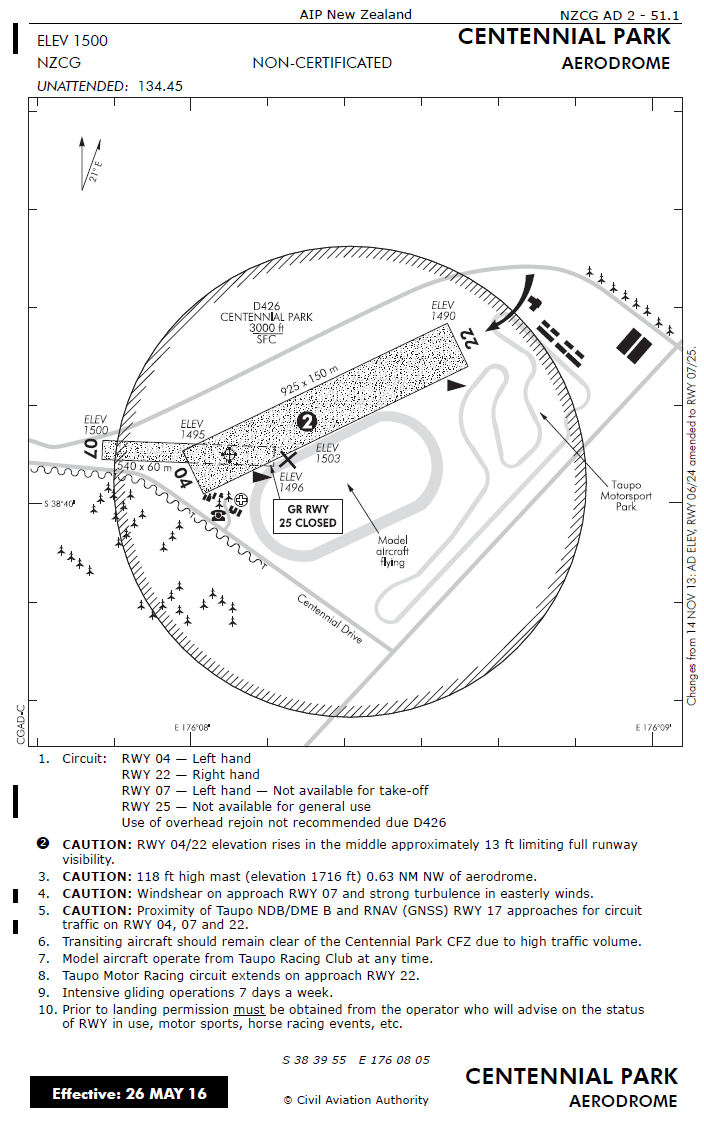
Appendix 2. Beaufort scale
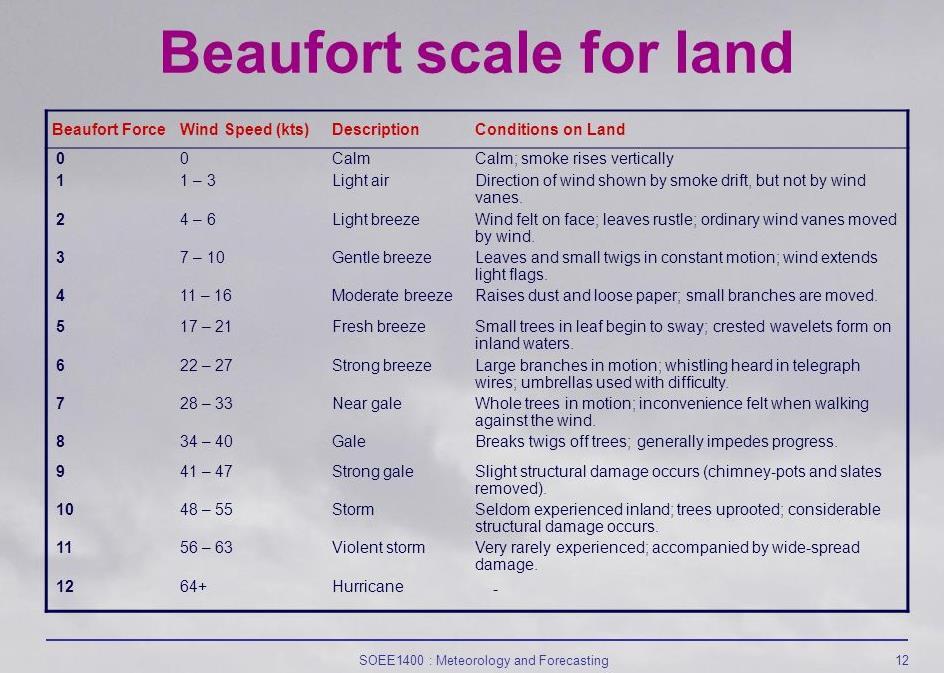
Appendix 3. Glider launch trend data 2006-2020
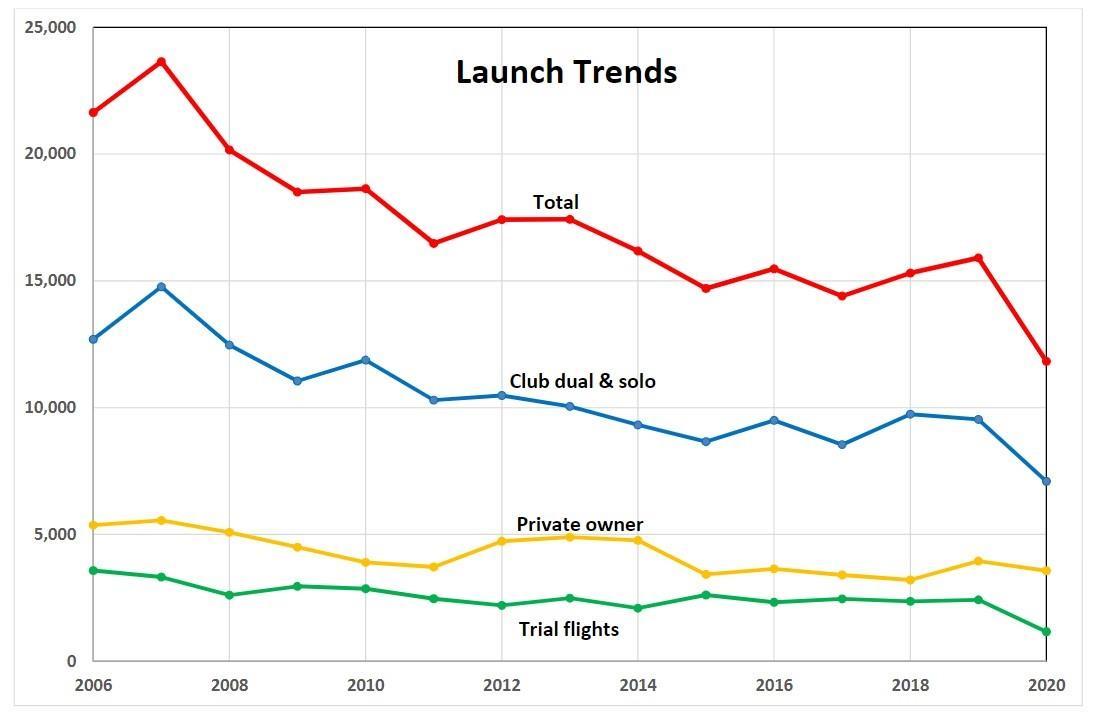
Appendix 4. Requirements for passenger flights
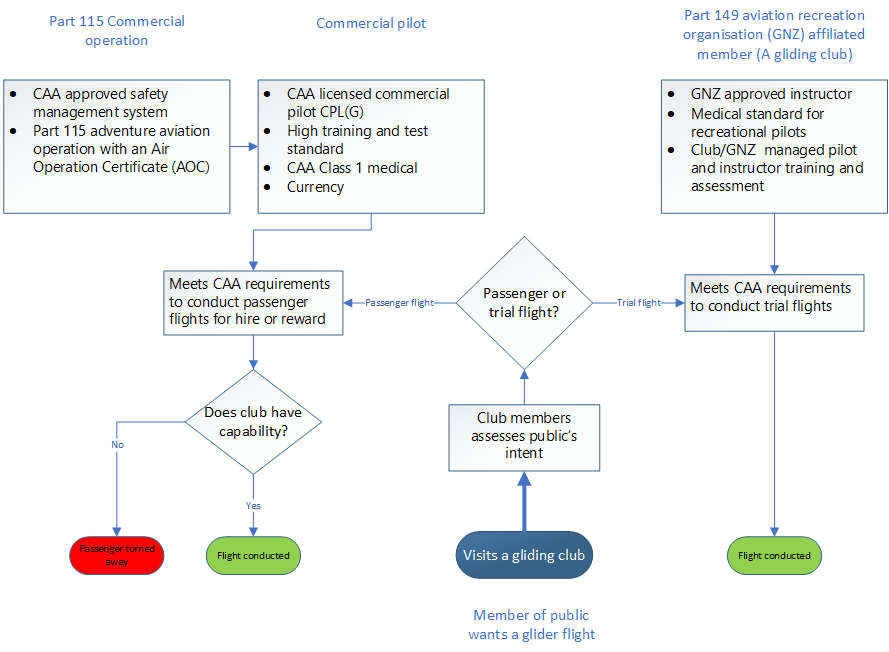
Related Recommendations
On 27 September 2023 the Commission recommended that the Taupo Gliding Club develop and implement a system approved by GNZ that ensures instructors can positively verify that pilots have an appropriate level of competency to ridge soar on Mount Tauhara and safely conduct training flights on the ridge.
On 27 September 2023 the Commission recommended that Gliding New Zealand review how gliding club instructors are trained, and clubs are audited, and then take corrective action to ensure that all new instructors are consistently trained to the standards set out in the Manual of Approved Procedures (MOAP)
